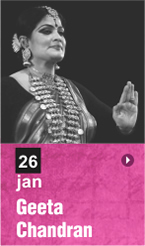


Isha Sharvani and Daksha Sheth Dance Company presents - SHIVA-SHAKTI
Directed by: Devissaro
Choreographed by: Daksha Sheth
Well-known Indian contemporary dancer and actress Isha Sharvani, the lead dancer in The Daksha Sheth Dance Company, presents an enchanting performance themed around the cosmic union of Shiva and Shakti. In the ancient Indian philosophy of Tantra, it is said that the Kundalini Shakti, not only exists in every atom of every human being but also in every atom of the universe. Shiva is the male principle, pure consciousness, the un-manifest, denoted in Tantric texts by the white upward facing triangle. Shakti is the dynamic feminine energy, the manifest, denoted by the red downward facing triangle. The universe in all its diversity arises from the union of these two principles. In its dormant state, Kundalini Shakti is represented by a coiled snake, nestled at the base of the spine. When this energy is awakened, it ascends through the 7 chakras to unite above the crown of the head with Shiva. This consummation creates an experience of bliss. This Kundalini Shakti in each one of us unites us and connects us in the dance of Shiva. The Daksha Sheth Dance Company has presented their Indian contemporary dance work in more than 30 different countries and in more than 25 international festivals.
Place: Navlakhi Compound, Opp. Narmada Bhavan ![]()
Time: 6 pm – 7:30 pm

Eminent dancer Geeta Chandran will give a solo performance on her new abstract dance-theatre concept in Vadodara. Gandhi: Warp & Weft has been created by Geeta Chandran and Deepa Dharmadhikari with initial financial assistance from the Government of India’s Ministry of Culture. It comprises six concepts interpreted through dance that flow contiguously from one to the other. The first concept is of religious unity, and is connected to the deep reliance on spiritual syncretism that Gandhi had. In the second section the dancer visits Gandhi’s experiments with celibacy and renunciation, by moving from shringara to virakti. The third theme the choreography engages with is satyagraha, and is inspired by Gandhi’s prison writings, his mass civil disobedience movements, and epochal moments like the Dandi March. Ahimsa, both in the concept of turning the other cheek in peace, as well as the violence inflicted on the self through such radical protests like hunger strikes. The fifth section looks at caste and shram with an eye to both the reformations of the past that Gandhi sought regarding the dignity of labour, as well as the atrocities of caste oppression that continue in the present day. In the concluding section, the dancer uses khadi and the spinning, weaving and cloth-making processes as an extended metaphor for the idea of ecological sustainability and balance. Thread becomes a symbol for many things, and can be seen as both a bond uniting and a line dividing, within the context of Gandhian ideals.
Place: FGI Auditorium ![]()
Time: 6 pm – 7 pm